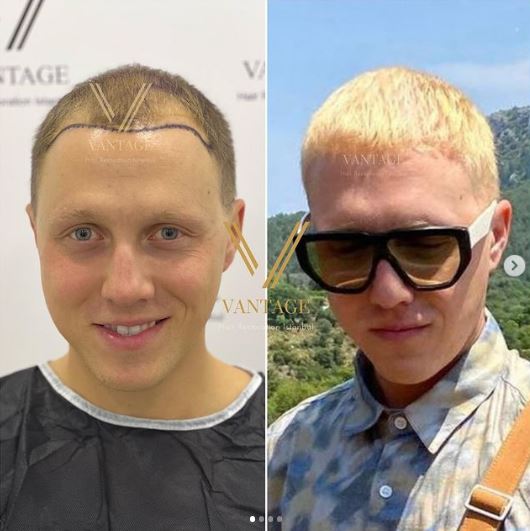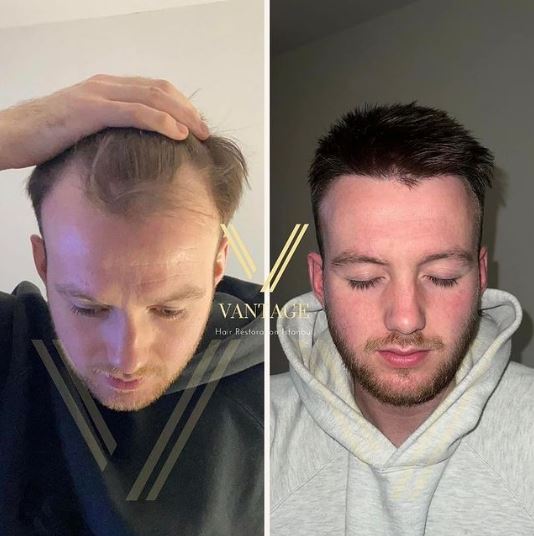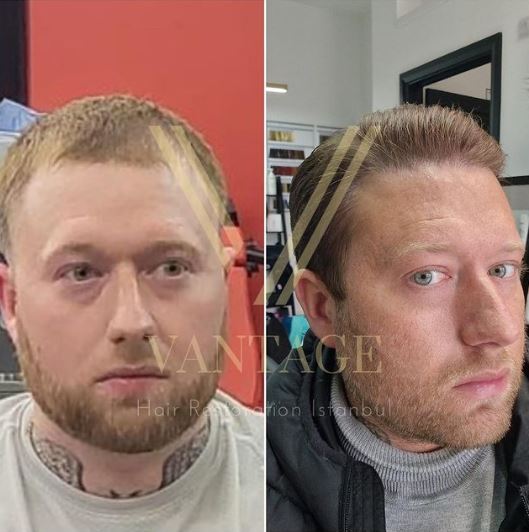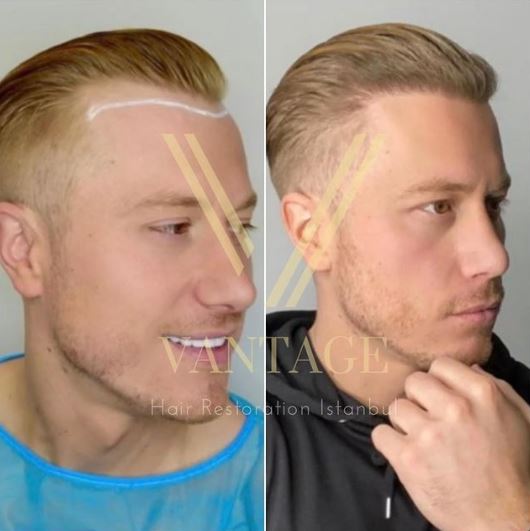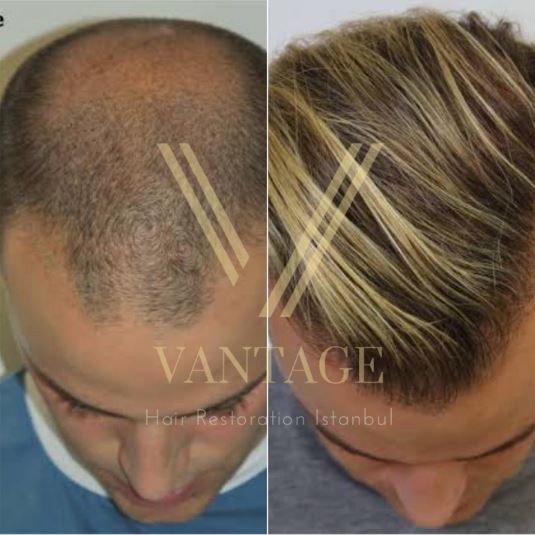
Curious about the hair transplant success rate? You’re not alone. With more and more individuals turning to hair transplant methods to combat hair loss, it becomes increasingly important to understand the factors influencing success rates.
Due to its popularity, there are several questions about the details of the procedure, such as what the hair transplant success rate is for each country and what can be done to increase this rate. So, read on to find out more!
What is the success rate of a hair transplant?
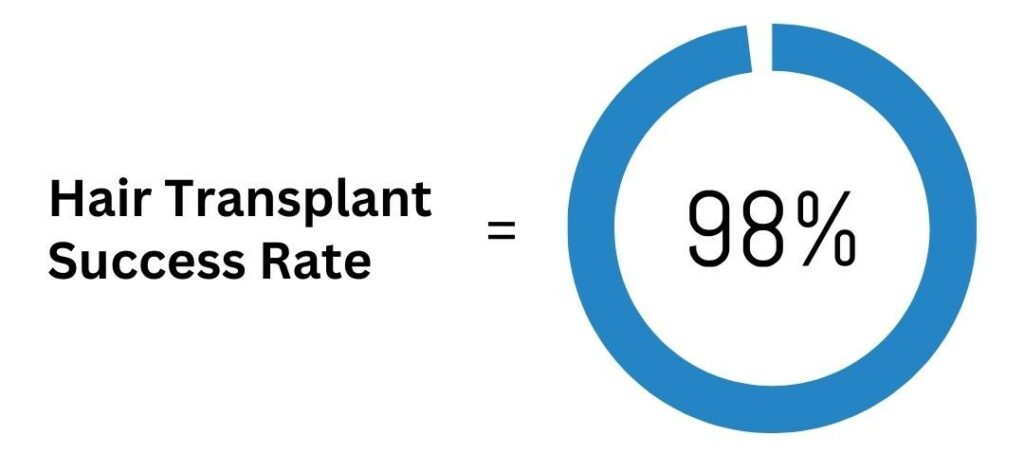
Hair transplant procedures are highly effective and long-lasting, making them a popular choice for those looking to restore their hairline. The success of the procedure depends mainly on various factors, including the availability of the donor area, the location and extent of hair loss, and the surgeon’s expertise. Additionally, the success rate may vary depending on the method used. Therefore, it is essential to understand the success rates of each hair transplant method to make an informed decision.
What is the success rate of FUE hair transplant?
FUE, which stands for Follicular Unit Extraction, is one of the most popular hair transplant methods in the world. This is mainly due to the convenience and capability of coverage in wide areas. The FUE method is based on the extraction and implantation of hair follicles individually. With FUE method, up to 5,000 grafts can be transplanted in a single session. Furthermore, when performed by a qualified specialist, FUE hair transplant yields up to %98 success rate.

What is the success rate of DHI hair transplant?
DHI is another popular hair transplant method that works exactly like FUE. It also works by extracting and implanting hair follicles individually. However, with a slight alteration from FUE, DHI utilizes a specialized tool called Choi Pen. This tool makes it feasible to get a hair transplant without creating microchannels.
Another advantage of DHI is that it allows for higher density in smaller areas. However, since it requires more precision, DHI takes longer to perform. Despite this, the DHI hair transplant success rate may range up to %98. Overall, DHI can be an excellent option for those looking for a successful hair transplant.
What is the success rate of FUT hair transplant?
FUT is one of the earliest hair transplant methods, developed in the late 1980s and ’90s. However, in recent years, this method has become the least favored compared to FUE and DHI due to its outdated working mechanism. In the FUT method, hair follicles are extracted as a strip, resulting in linear scars in the donor area, which may reduce the procedure’s success rate. On average, the overall success rate of FUT hair transplant ranges from 90% to 95%.
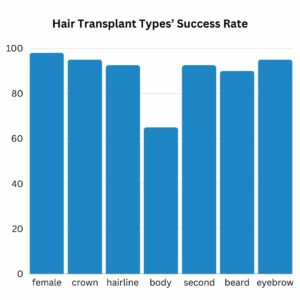
Can women get hair transplants?
Hair loss can be a distressing experience for both men and women. Fortunately, hair transplant surgery is a viable option for both genders. Female hair transplant is especially helpful for women who suffer from hair loss due to various reasons such as stress, aging, menopause, and more. The good news is that women’s hair transplant methods are no different than those applied to men. In fact, hiding the traces of female hair transplants is much easier for women rather than men. So, if you are a woman experiencing hair loss, you can consider getting a hair transplant and enjoy the benefits of a fuller head of hair.

What is the success rate of female hair transplant?
When it comes to female hair transplants, it’s important to note that the success rate is no different than hair transplants for men. However, the success rate of a female hair transplant does depend on a few factors, including the extent and location of hair loss, the expertise of the surgeon, and the viability of the donor area. That being said, when performed by a qualified specialist, the female hair transplant success rate may go up to as high as %98.
Can you get hair transplant on crown?
Yes, it is possible to get a hair transplant on the crown area of your head, and you can achieve successful results similar to a hair transplant for the hairline. The crown, also known as the vertex, is the highest part of the scalp. However, due to its location, the blood circulation in this area is relatively slow compared to other areas such as the hairline and temples. This feature of the crown area may potentially slow down hair growth. To sum up, while it is possible to get a hair transplant on the crown, it is important to keep in mind that transplanted hair may take a bit longer to grow.

What is the success rate of crown area hair transplant?
Due to its location and round shape, the crown area can pose a challenge for those seeking a hair transplant. This is because the area’s shape can slow blood flow, which can delay visible results. However, with a qualified specialist and a healthy donor area, a crown hair transplant can offer successful results. In fact, the hair transplant crown area success rate is as high as 95%.
Can hair transplant fix receding hairline?
Many individuals, especially those with male pattern baldness, experience a receding hairline as the first sign of hair loss. However, the good news is that hair transplants can effectively reduce receding hairlines and help you achieve a more youthful appearance. Nevertheless, it’s essential to keep in mind that you should have a sufficient donor area to achieve a fuller coverage on hairline.
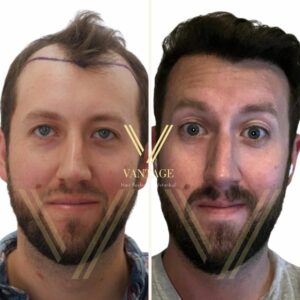
What is the success rate of hair transplants for receding hairlines?
Hair transplants for receding hairline can provide successful results when performed by a qualified specialist using a suitable method. The success rate of the surgery depends on factors such as the extent of hairline recession, the viability of the donor area, and the texture of the hair follicles. Typically, the success rate of hair transplant surgery for hairline restoration ranges between 90-95%. Additionally, it’s possible to increase the success rate for hair transplants through proper care and maintenance.
Can body hair be used for hair transplant?
Hair cells have unique shape, diameter, and texture depending on their location in the body. When it comes to hair transplant, the selection of donor area takes these factors into account. Typically, the donor area is chosen from the back of the scalp, where hair follicles are less likely to fall. In rare cases where scalp hair is insufficient or unavailable, body hair may also be used for transplant.
What is the success rate of body hair transplant?
Usually, chest hair is chosen for body hair transplant as it most closely resembles scalp hair. Apart from the difference in the donor area of hair follicles, body hair transplant, and conventional hair transplant methods follow the same process. Due to the differences in the quality of scalp and body hair, the success rate of body hair transplant is generally lower than that of scalp hair transplant. When performed by a skilled surgeon, the body hair transplant success rate may range between 60-70%.
Can you get a second hair transplant?
A hair transplant is a comprehensive procedure that involves extracting hair follicles from the donor area and implanting them into the balding or thinning area on the scalp. The procedure is designed to help you achieve the desired density of hair, usually in a single session. However, in some cases, a second hair transplant may be necessary if the donor area is unsuitable for a single transplant or if an individual did not achieve the desired results with the first transplant.

What is the success rate of second hair transplant?
In light of the importance of proper recovery, it is advisable to wait for your first hair transplant to recover completely before considering a second one. Once you are fully healed, you can start to explore the possibility of a second hair transplant. It is important to note that second hair transplants require more expertise and precision than the first one, which means that the procedure may take a little longer. Nonetheless, with the right surgeon and a viable donor area, the success rate of a second hair transplant is generally high, averaging around 90-95%.
What is the success rate of facial hair transplant?
Facial hair transplant is a commonly sought-after procedure to achieve the desired density and well-groomed appearance of facial hair. This procedure has a high success rate, which depends on several factors, including the expertise of the surgeon, the extent of the balding area, and the viability of the donor area. Furthermore, it is essential to note that the success of a facial hair transplant is also influenced by the patient’s overall health and adherence to post-operative care instructions.
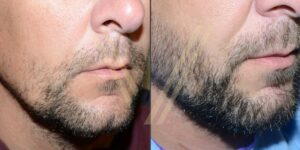
What is the success rate of beard transplant?
The success rate of beard transplant surgery may vary due to various factors, such as the surgeon’s experience and skills, the quality and viability of the donor area, the transplant technique used, and the patient’s characteristics. Generally, however, the success rate ranges from 85% to 95%.
It’s crucial to consult with a qualified and experienced surgeon who can provide personalized recommendations regarding the likelihood of success for a beard transplant. Please feel free to contact our medical consultants to learn more about beard transplant surgery.

What is the success rate of eyebrow transplant?
Eyebrow transplants are an effective solution for those who want to restore or enhance their eyebrow’s appearance. The procedure is similar to a hair transplant, but it covers a smaller area, making it easier to recover. The success rate of the transplantation depends on the surgeon’s experience and the viability of the donor area. With proper care and maintenance, the results are long-lasting, providing a natural and fuller-looking eyebrow. Generally, eyebrow transplant success rate ranges around 95%.
How to enhance success rate of hair transplant?
To achieve successful results from a hair transplant, realistic expectations are essential. This means being aware of what is achievable and not setting your hopes too high. In addition, to avoid further hair loss afterward, it is important to ensure that your hair loss has stabilized before proceeding with the procedure. Therefore, it is recommended that you consult with a qualified and experienced surgeon to discuss the best course of action that suits your needs and expectations.
Moreover, the success rate of hair transplants depends on your lifestyle choices, such as habits, etc. For instance, the hair transplant success rate in smokers may be lower than in non-smokers, as smoking may lead to hair loss after the procedure.
Once the procedure is completed, there are several things that you can do to ensure successful results. First and foremost, it is essential to take proper care of your hair. This includes staying hydrated, avoiding hair care products that contain harsh chemicals, and refraining from heavy exercise until the hair grafts have settled. Furthermore, following a healthy diet that includes nutrients that are beneficial for hair follicles can also help to enhance the hair transplant surgery success rate. By doing so, you can enhance the growth of new hair and maintain the results for a longer time.
How much does a hair transplant cost?

A hair transplant is a highly advanced procedure that requires a great deal of expertise and precision, which is why it can be costly. In most countries, the cost of a hair transplant is calculated based on the number of grafts required. On average, a hair transplant can cost anywhere between $5,000 and $13,500 globally. The cost of the procedure can vary depending on factors such as the surgeon’s level of expertise, the location of the clinic, and the method used for the transplant. It is also important to note that there may be additional expenses, such as transportation and accommodation, that you will need to consider.
How much does a hair transplant cost in Turkey?
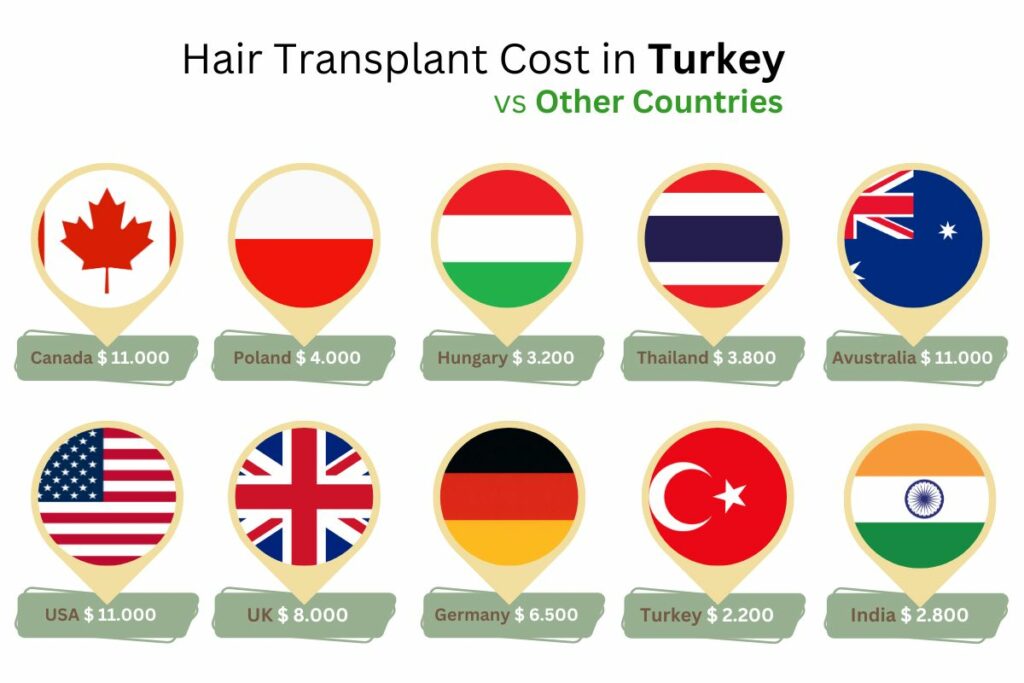
Turkey is widely recognized as a central location for hair transplant procedures, owing to its successful results and highly qualified experts. It is also renowned as a destination where convenience meets expertise. With its low exchange rate and cost of living, getting a hair transplant in Turkey is much more affordable than in other countries. Furthermore, unlike other countries, hair transplant prices in Turkey are determined based on the extent of hair loss and the method utilized for the procedure rather than the cost per graft, making it more budget-friendly.
Hair transplant clinics in Turkey have become a popular destination for people seeking the procedure due to the competitive environment that has led to many clinics offering all-inclusive packages at competitive prices to ensure a hassle-free experience for their clients. If you are interested in exploring all-inclusive packages, be sure to check out the options available to you. On average, the cost of a hair transplant in Turkey ranges from $2,400 to $4,000, depending on the method used during the procedure.
FAQs About Hair Transplant Success Rate
What is the success rate of hair transplants in Turkey compared to other countries?
Turkey boasts as a leading destiantion for hair medical tourism. Thanks to investments and improvements in the medical health industry, Turkey not only become an affordable option, also becomes a safer destination. The success rate of hair transplants in Turkey is higher compared to the other countries since healthcare facilitiess are regulated periodically by the Ministry of Health.
How do I know if my hair transplant successful?
To determine the success of a hair transplant, you need to wait for the hair follicles to enter the growing phase. Following a hair transplant, the donor area heals within the first two weeks, and hair grafts begin to settle into the recipient area. Shock loss, which is a common occurrence, starts towards the middle and end of the first month after the procedure. After the shock loss phase, initial growth begins 2-3 months after the procedure. Your hair will continue to grow from this point until the end of the year, and at that point, you can assess whether the hair transplant was successful or not.
How long should I protect my head to ensure hair grafts settle successfully?
After a hair transplant, it’s crucial to take proper care of your hair grafts to ensure a healthy recovery phase and enhance the success rate of the results. To achieve this, it’s recommended that you avoid touching or scratching your scalp for at least a week after the procedure. Additionally, for the first three weeks, it’s best to avoid activities that may cause excessive sweating or heat exposure, such as hot baths or saunas, which could potentially affect hair growth. By following these simple guidelines, you can help ensure the best possible outcome of your hair transplant.


